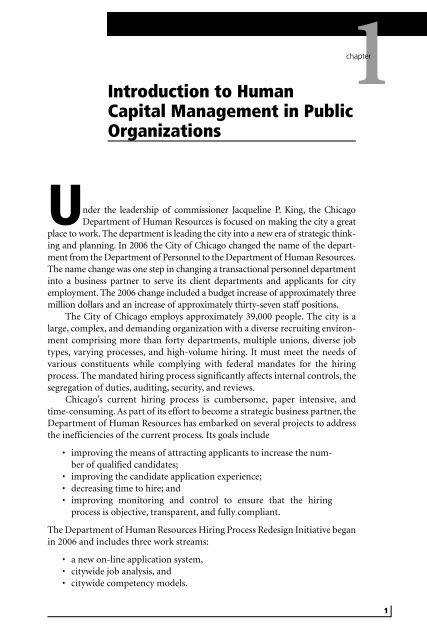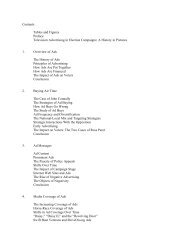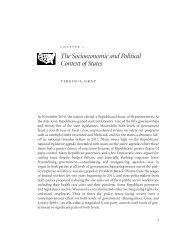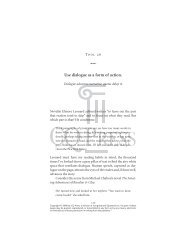Introduction to Human Capital Management in Public ... - CQ Press
Introduction to Human Capital Management in Public ... - CQ Press
Introduction to Human Capital Management in Public ... - CQ Press
Create successful ePaper yourself
Turn your PDF publications into a flip-book with our unique Google optimized e-Paper software.
010 Selden Ch01 (1-12).qxd 4/29/08 12:59 PM Page 1<br />
<strong>Introduction</strong> <strong>to</strong> <strong>Human</strong><br />
<strong>Capital</strong> <strong>Management</strong> <strong>in</strong> <strong>Public</strong><br />
Organizations<br />
1<br />
chapter<br />
Under the leadership of commissioner Jacquel<strong>in</strong>e P. K<strong>in</strong>g, the Chicago<br />
Department of <strong>Human</strong> Resources is focused on mak<strong>in</strong>g the city a great<br />
place <strong>to</strong> work. The department is lead<strong>in</strong>g the city <strong>in</strong><strong>to</strong> a new era of strategic th<strong>in</strong>k<strong>in</strong>g<br />
and plann<strong>in</strong>g. In 2006 the City of Chicago changed the name of the department<br />
from the Department of Personnel <strong>to</strong> the Department of <strong>Human</strong> Resources.<br />
The name change was one step <strong>in</strong> chang<strong>in</strong>g a transactional personnel department<br />
<strong>in</strong><strong>to</strong> a bus<strong>in</strong>ess partner <strong>to</strong> serve its client departments and applicants for city<br />
employment. The 2006 change <strong>in</strong>cluded a budget <strong>in</strong>crease of approximately three<br />
million dollars and an <strong>in</strong>crease of approximately thirty-seven staff positions.<br />
The City of Chicago employs approximately 39,000 people. The city is a<br />
large, complex, and demand<strong>in</strong>g organization with a diverse recruit<strong>in</strong>g environment<br />
compris<strong>in</strong>g more than forty departments, multiple unions, diverse job<br />
types, vary<strong>in</strong>g processes, and high-volume hir<strong>in</strong>g. It must meet the needs of<br />
various constituents while comply<strong>in</strong>g with federal mandates for the hir<strong>in</strong>g<br />
process. The mandated hir<strong>in</strong>g process significantly affects <strong>in</strong>ternal controls, the<br />
segregation of duties, audit<strong>in</strong>g, security, and reviews.<br />
Chicago’s current hir<strong>in</strong>g process is cumbersome, paper <strong>in</strong>tensive, and<br />
time-consum<strong>in</strong>g. As part of its effort <strong>to</strong> become a strategic bus<strong>in</strong>ess partner, the<br />
Department of <strong>Human</strong> Resources has embarked on several projects <strong>to</strong> address<br />
the <strong>in</strong>efficiencies of the current process. Its goals <strong>in</strong>clude<br />
• improv<strong>in</strong>g the means of attract<strong>in</strong>g applicants <strong>to</strong> <strong>in</strong>crease the number<br />
of qualified candidates;<br />
• improv<strong>in</strong>g the candidate application experience;<br />
• decreas<strong>in</strong>g time <strong>to</strong> hire; and<br />
• improv<strong>in</strong>g moni<strong>to</strong>r<strong>in</strong>g and control <strong>to</strong> ensure that the hir<strong>in</strong>g<br />
process is objective, transparent, and fully compliant.<br />
The Department of <strong>Human</strong> Resources Hir<strong>in</strong>g Process Redesign Initiative began<br />
<strong>in</strong> 2006 and <strong>in</strong>cludes three work streams:<br />
• a new on-l<strong>in</strong>e application system,<br />
• citywide job analysis, and<br />
• citywide competency models.<br />
1
010 Selden Ch01 (1-12).qxd 4/29/08 12:59 PM Page 2<br />
2 CHAPTER 1<br />
The City of Chicago has over 1,500 job titles. The purpose of the citywide<br />
job analysis is <strong>to</strong> ensure that all of the job descriptions are current and conform<br />
<strong>to</strong> <strong>in</strong>dustry standards and <strong>to</strong> recommend consolidation of titles where appropriate.<br />
The city is develop<strong>in</strong>g a citywide Core Competency Model, as well as<br />
job-specific functional competencies. Chicago’s charge is not only <strong>to</strong> recruit<br />
specific talent, but <strong>to</strong> recruit <strong>in</strong>dividuals who are ethical, accountable, and loyal<br />
<strong>to</strong> the public <strong>in</strong>terest.<br />
Motivat<strong>in</strong>g and reta<strong>in</strong><strong>in</strong>g excellent employees are also goals of the City of<br />
Chicago. In 2008 the Department of <strong>Human</strong> Resources will launch a citywide<br />
new-employee orientation program, as well as enhance its tra<strong>in</strong><strong>in</strong>g and professional<br />
development programs. Commissioner K<strong>in</strong>g has said that that the<br />
rewards of public service are not always material. They can be moral, psychological,<br />
or even spiritual. Accord<strong>in</strong>g <strong>to</strong> K<strong>in</strong>g, Chicago’s development programs<br />
will highlight and emphasize the rewards of public service.<br />
The City of Chicago wants <strong>to</strong> cont<strong>in</strong>ually f<strong>in</strong>d ways <strong>to</strong> improve its<br />
processes, <strong>in</strong>clud<strong>in</strong>g the post<strong>in</strong>g of positions; recruit<strong>in</strong>g, screen<strong>in</strong>g, and selection;<br />
hir<strong>in</strong>g activities; and tra<strong>in</strong><strong>in</strong>g and development. In transform<strong>in</strong>g the<br />
Department of <strong>Human</strong> Resources, Commissioner K<strong>in</strong>g believes, the city will<br />
create a high-perform<strong>in</strong>g, values-based organization that will attract, motivate,<br />
and reta<strong>in</strong> talented public service employees. The city’s ultimate goal, however,<br />
is <strong>to</strong> ensure that its improved processes have a direct and positive impact on<br />
service delivery <strong>to</strong> the taxpayers of Chicago.<br />
The Chicago example illustrates the ways <strong>in</strong> which governments are<br />
chang<strong>in</strong>g how they operate their civil service systems, even <strong>in</strong> environments<br />
where change might not be expected. Chicago’s civil service is over one hundred<br />
years old, labor unions are strong, and politics is highly centralized <strong>in</strong> the<br />
political mach<strong>in</strong>ery (Kasperson 1965). These are all conditions that might create<br />
barriers <strong>to</strong> modernization. However, as illustrated throughout this book,<br />
the types of changes occurr<strong>in</strong>g <strong>in</strong> Chicago are happen<strong>in</strong>g throughout federal,<br />
state, and local governments.<br />
HUMAN CAPITAL MANAGEMENT IN PUBLIC SYSTEMS<br />
<strong>Human</strong> capital management (HCM) is an essential component of any public<br />
management system. It refers <strong>to</strong> the systems, policies, procedures, and practices<br />
of manag<strong>in</strong>g human capital with<strong>in</strong> public organizations, whether merit or nonmerit<br />
systems, civil or non–civil services. The term is often used <strong>in</strong>terchangeably<br />
with “human resource management” and “personnel management.” However,<br />
practitioners, such as David Walker, comptroller general of the United States,<br />
and scholars use the term “human capital” <strong>to</strong> emphasize the importance of people<br />
<strong>to</strong> the success of government and the need <strong>to</strong> change the ways employers and<br />
organizations <strong>in</strong>teract. In an extensive review of human capital efforts of federal<br />
agencies, the Center for Innovation <strong>in</strong> <strong>Public</strong> Service outl<strong>in</strong>ed four guideposts<br />
for human capital management. Organizations need <strong>to</strong>
010 Selden Ch01 (1-12).qxd 4/29/08 12:59 PM Page 3<br />
<strong>Introduction</strong> <strong>to</strong> <strong>Human</strong> <strong>Capital</strong> <strong>Management</strong> <strong>in</strong> <strong>Public</strong> Organizations 3<br />
• recognize and manage employees as critical assets;<br />
• strategically plan and manage staff<strong>in</strong>g;<br />
• prioritize/plan human capital costs for susta<strong>in</strong>ed <strong>in</strong>vestment; and<br />
• openly engage employees via communication and collaboration<br />
channels.(Center for Innovation <strong>in</strong> <strong>Public</strong> Service 2006, 4)<br />
The primary goal of human capital management is <strong>to</strong> create a performance-aligned<br />
workforce by adopt<strong>in</strong>g HCM systems, policies, procedures, and<br />
practices that are driven by, or aligned with, an agency’s strategic mission and<br />
that are <strong>in</strong>ternally consistent and <strong>in</strong>tegrated (Center for Innovation <strong>in</strong> <strong>Public</strong><br />
Service 2006). In operation these practices are extensive and <strong>in</strong>clude strategic<br />
human capital and workforce plann<strong>in</strong>g, recruit<strong>in</strong>g prospective employees,<br />
select<strong>in</strong>g employees and leaders, tra<strong>in</strong><strong>in</strong>g and develop<strong>in</strong>g employees, manag<strong>in</strong>g<br />
employee rewards and recognition, evaluat<strong>in</strong>g employee performance, classify<strong>in</strong>g<br />
positions, creat<strong>in</strong>g a positive and safe work environment (employee relations),<br />
and adm<strong>in</strong>ister<strong>in</strong>g employee benefits.<br />
The aim of this book is <strong>to</strong> engage public organizations <strong>in</strong> the strategic<br />
management of their human capital. The objective is <strong>to</strong> move away from a fragmented<br />
approach <strong>to</strong> human capital management and <strong>to</strong>ward an approach that<br />
facilitates the <strong>in</strong>tegration of human capital <strong>in</strong><strong>to</strong> the overall strategic management<br />
of public agencies. This movement requires that human capital decisions<br />
be based on evidence or data. For that <strong>to</strong> occur, public organizations must<br />
establish performance metrics that will enable them <strong>to</strong> moni<strong>to</strong>r, identify, and<br />
diagnose human capital opportunities and challenges. This chapter discusses<br />
• how governments organize their human capital systems,<br />
• how the scope of human capital activities has expanded, and<br />
• a framework for plann<strong>in</strong>g, align<strong>in</strong>g, and assess<strong>in</strong>g human capital<br />
management.<br />
HOW GOVERNMENTS ORGANIZE<br />
THEIR HUMAN CAPITAL SYSTEMS<br />
An organization’s human capital system comprises components that sometimes<br />
work <strong>to</strong>gether and sometimes clash. A public organization’s human capital<br />
system is embedded with<strong>in</strong> larger political relationships, and its<br />
components are shaped by public op<strong>in</strong>ion, legislation, regulations, union contracts,<br />
and his<strong>to</strong>ry. Each political organization has its own unique set of environmental<br />
<strong>in</strong>fluences that need <strong>to</strong> be taken <strong>in</strong><strong>to</strong> account. Legislation, judicial<br />
decisions, executive orders, and regulations related <strong>to</strong> the merit system and<br />
labor relations all may come <strong>in</strong><strong>to</strong> play (for a thorough review of these issues see<br />
Ingraham 1995; Mosher 1968; and Van Riper 1958).<br />
Prior <strong>to</strong> the passage of the Pendle<strong>to</strong>n Act <strong>in</strong> 1883, elected officials largely<br />
decided who was appo<strong>in</strong>ted <strong>to</strong> work for the government (Hoogenboom 1959).
010 Selden Ch01 (1-12).qxd 4/29/08 12:59 PM Page 4<br />
4 CHAPTER 1<br />
Although orig<strong>in</strong>ally the act only required a limited share of the “classified service”<br />
<strong>to</strong> be selected by competitive exam, it was extended over time <strong>to</strong> cover more<br />
and more employees. The classified service <strong>in</strong>cludes po,, taOver time merit systems<br />
diffused through all levels of government and public bureaucracies, as<br />
political mach<strong>in</strong>es were transformed <strong>in</strong><strong>to</strong> professionally adm<strong>in</strong>istered <strong>in</strong>stitutions<br />
(Hoogenboom 1959). Carolyn Ban and Norma Riccucci (2002) write,<br />
“<strong>Public</strong> personnel management, for better or worse, cont<strong>in</strong>ues <strong>to</strong> embody the<br />
concept of merit. Notwithstand<strong>in</strong>g, the nature of civil service and the personnel<br />
practices which susta<strong>in</strong> it have changed considerably s<strong>in</strong>ce 1883.”<br />
In addition <strong>to</strong> merit-based hir<strong>in</strong>g, most civil service systems give employees<br />
other adm<strong>in</strong>istrative and legal due process rights, such as a right <strong>to</strong> grieve or<br />
appeal an employment decision (e.g., on promotion or compensation) or a<br />
decision <strong>to</strong> discharge them for cause, and protection from partisan pressure<br />
and removal (Mosher 1968). In the past decade some governments have tried<br />
<strong>to</strong> elim<strong>in</strong>ate the classified civil service. A few states, such as Georgia and<br />
Florida, have shifted at least part of the legal basis of their employment systems<br />
from a civil service structure <strong>to</strong> an employment-at-will model. Employment at<br />
will typically connotes an employer’s right <strong>to</strong> term<strong>in</strong>ate an employee without a<br />
reason and an employee’s right <strong>to</strong> leave when she or he elects (Baucus and<br />
Dwork<strong>in</strong> 1998; Fulmer and Casey 1990). 1 The Department of Homeland Security<br />
has an at-will human capital system <strong>in</strong>dependent of the federal classified<br />
service. Although most governments operate a classified civil service or merit<br />
system, the percentage of employees covered by it varies. For example, <strong>in</strong> 2008,<br />
only 60 percent of Indiana’s state government was part of its classified civil<br />
service, whereas more than 99 percent of North Carol<strong>in</strong>a’s workforce was covered<br />
by its merit system (GPP 2007). The adm<strong>in</strong>istrative and legal protections<br />
that these systems provide public employees vary.<br />
The structure of civil service systems also varies across governments, with<br />
some largely decentralized and others very centralized. The purported benefits<br />
of a centralized structure <strong>in</strong>clude equitable treatment of employees, consistency<br />
<strong>in</strong> the delivery of services, efficiency ga<strong>in</strong>s through economies of scale,<br />
and clear division of functions between the central human resource department<br />
and agencies. In the 1990s many scholars and practitioners pushed for<br />
central human resources departments <strong>to</strong> decentralize authority over some<br />
human resource practices <strong>to</strong> give more flexibility <strong>to</strong> public agencies and their<br />
managers (Kellough and Nigro 2006). Today responsibilities are often shared<br />
by a central human capital department or agency, such as the U.S. Office of Personnel<br />
<strong>Management</strong> (OPM), and other agencies, such as the U.S. Environmental<br />
Protection Agency and the U.S. Department of the Treasury.<br />
1 Both federal legislation and state laws provide exceptions <strong>to</strong> the doctr<strong>in</strong>e of at will, <strong>in</strong>clud<strong>in</strong>g, but<br />
limited <strong>to</strong>, participation <strong>in</strong> union activities, whistle blow<strong>in</strong>g, public policy, employer motivation,<br />
race, ethnicity, religion, national orig<strong>in</strong>, sex, and disabilities (Fulmer & Casey, 1990). Montana is<br />
the only state that has passed legislation that prohibits employers from discharg<strong>in</strong>g employees<br />
without “good cause” (Falcone, 1999; Wallihan, 2003).
010 Selden Ch01 (1-12).qxd 4/29/08 12:59 PM Page 5<br />
<strong>Introduction</strong> <strong>to</strong> <strong>Human</strong> <strong>Capital</strong> <strong>Management</strong> <strong>in</strong> <strong>Public</strong> Organizations 5<br />
Labor relations—the spectrum of <strong>in</strong>teractions among public employees,<br />
public managers, and <strong>in</strong>stitutions (governments and unions)—also <strong>in</strong>fluence<br />
<strong>to</strong>day’s public human capital systems. The academic literature on labor relations<br />
is vast. There is great variation <strong>in</strong> labor relations across governments,<br />
depend<strong>in</strong>g on the extent of unionization; the scope, nature, and number of<br />
issues over which unions barga<strong>in</strong>; the laws that govern collective barga<strong>in</strong><strong>in</strong>g<br />
processes; the locus of authority <strong>to</strong> negotiate labor contracts; and the contentiousness<br />
of the barga<strong>in</strong><strong>in</strong>g process. In some governments, employees may<br />
jo<strong>in</strong> a union, but the union has no formal authority <strong>to</strong> negotiate employment<br />
contracts on behalf of its members. In governments where collective barga<strong>in</strong><strong>in</strong>g<br />
is allowed, there are often restrictions on which employment actions can be<br />
barga<strong>in</strong>ed. As with merit systems, there is not a common legal framework govern<strong>in</strong>g<br />
the labor relations of state and local governments (see Cayer 1996).<br />
CHANGING PERSPECTIVE<br />
His<strong>to</strong>rically public personnel management had a strong functional focus that<br />
emphasized the adm<strong>in</strong>istration and regulation of civil service and other public<br />
personnel systems and policies—such as job classification, hir<strong>in</strong>g, discipl<strong>in</strong>e,<br />
performance evaluation, tra<strong>in</strong><strong>in</strong>g, and compensation—used <strong>to</strong> manage people<br />
<strong>in</strong> an organization (Pynes 1997). <strong>Public</strong> personnel agencies were typically<br />
organized <strong>in</strong><strong>to</strong> the aforementioned functions, with limited <strong>in</strong>tegration across<br />
the functions (Wright and McMahan 1992). Although some cont<strong>in</strong>ue <strong>to</strong> view<br />
human resources traditionally, <strong>in</strong>creas<strong>in</strong>gly public organizations are <strong>in</strong>tegrat<strong>in</strong>g<br />
the traditional responsibilities of manag<strong>in</strong>g personnel systems with strategic<br />
human capital management (Center for Innovation <strong>in</strong> the <strong>Public</strong> Sec<strong>to</strong>r 2006).<br />
A strategic human capital perspective suggests that an organization is forward<br />
th<strong>in</strong>k<strong>in</strong>g and conceives of its human capital as a valuable asset <strong>to</strong> the government.<br />
It implies that human capital can play a strategic role <strong>in</strong> the<br />
organization’s success. Wright and McMahan (1992, 298) def<strong>in</strong>e it as “the pattern<br />
of planned human resource deployments and activities <strong>in</strong>tended <strong>to</strong> enable<br />
the [organization] <strong>to</strong> achieve its goals.”As a result of this shift <strong>in</strong> the field, HCM<br />
departments are shift<strong>in</strong>g from a preoccupation with polic<strong>in</strong>g the merit or civil<br />
service system and its rules <strong>to</strong> a broader human resources or human capital<br />
perspective that emphasizes plann<strong>in</strong>g, collaboration, and partnership with<br />
public leaders and managers <strong>to</strong> achieve government and agency goals (U.S.<br />
GAO 2002; Selden, Ingraham, and Jacobson 2001). <strong>Human</strong> capital management<br />
staff are mov<strong>in</strong>g away from primarily mak<strong>in</strong>g operational decisions <strong>to</strong><br />
act<strong>in</strong>g as consultants <strong>to</strong> other departments and managers, design<strong>in</strong>g and deliver<strong>in</strong>g<br />
policies and programs that give managers the <strong>to</strong>ols and tra<strong>in</strong><strong>in</strong>g they<br />
need <strong>to</strong> perform effectively <strong>in</strong> their positions. Below are three examples that<br />
illustrate the new role that central human resource offices are assum<strong>in</strong>g.<br />
The Office of Personnel <strong>Management</strong> is lead<strong>in</strong>g the federal government <strong>in</strong>itiative<br />
on strategic management of human capital. In conjunction with the
010 Selden Ch01 (1-12).qxd 4/29/08 12:59 PM Page 6<br />
6 CHAPTER 1<br />
BOX 1.1 Five Systems of the <strong>Human</strong> <strong>Capital</strong> Assessment<br />
and Accountability Framework<br />
Strategic Alignment (Plann<strong>in</strong>g and Goal Sett<strong>in</strong>g). A system led by senior management—<br />
typically the chief human capital officer (CHCO)—that promotes the alignment of human capital<br />
management strategies with agency mission, goals, and objectives through analysis, plann<strong>in</strong>g,<br />
<strong>in</strong>vestment, measurement, and management of human capital programs.<br />
Leadership and Knowledge <strong>Management</strong> (Implementation). A system that ensures cont<strong>in</strong>uity<br />
of leadership by identify<strong>in</strong>g and address<strong>in</strong>g potential gaps <strong>in</strong> effective leadership. It<br />
implements programs that capture organizational knowledge and promote learn<strong>in</strong>g.<br />
Results-Oriented Performance Culture (Implementation). A system that promotes a<br />
diverse, high-perform<strong>in</strong>g workforce through the use of effective performance management systems<br />
and awards programs.<br />
Talent <strong>Management</strong> (Implementation). A system that addresses competency gaps, particularly<br />
<strong>in</strong> mission-critical occupations, through programs <strong>to</strong> attract, acquire, develop, promote, and<br />
reta<strong>in</strong> quality talent.<br />
Accountability (Evaluat<strong>in</strong>g Results). A system that contributes <strong>to</strong> agency performance by moni<strong>to</strong>r<strong>in</strong>g,<br />
and evaluat<strong>in</strong>g the results of, its human capital management policies, programs, and activities.<br />
It analyzes compliance with merit system pr<strong>in</strong>ciples and identifies necessary improvements.<br />
Source: U.S. Office of Personnel <strong>Management</strong>,<br />
www.opm.gov/hcaaf_resource_center/assets/HCAAF_1_Intro.pdf.<br />
Office of <strong>Management</strong> and Budget (OMB) and the Government Accountability<br />
Office (GAO), OPM has developed a <strong>Human</strong> <strong>Capital</strong> Assessment and<br />
Accountability Framework <strong>to</strong> provide consistent guidance on human capital<br />
management for federal agencies (see Box 1.1).<br />
The Georgia Merit System partners with state agencies <strong>to</strong> hire, tra<strong>in</strong>, and<br />
reta<strong>in</strong> the workforce. It provides leadership for workforce plann<strong>in</strong>g and development,<br />
mediation and employee relations services, work-life services, tra<strong>in</strong><strong>in</strong>g and<br />
organizational development, compensation and staff<strong>in</strong>g services, salary development,<br />
recruitment and test<strong>in</strong>g services, and consultation services. It develops<br />
products and services for the enterprise of state government but also cus<strong>to</strong>mizes<br />
services for <strong>in</strong>dividual agencies, provides policy development and analysis, and<br />
provides employee benefits and f<strong>in</strong>ancial security services (GPP 2004).<br />
Wash<strong>in</strong>g<strong>to</strong>n State’s Department of Personnel (DOP) leads <strong>in</strong> build<strong>in</strong>g a performance-based<br />
culture that will help state government attract and reta<strong>in</strong> a<br />
highly capable and productive workforce. After consult<strong>in</strong>g with managers,<br />
employees, and human resource (HR) professionals <strong>in</strong> its cus<strong>to</strong>mer agencies<br />
about their needs and preferences, DOP develops and adopts the foundation<br />
HR system, <strong>in</strong>clud<strong>in</strong>g the personnel rules and job classification structure.<br />
Beyond that it focuses on provid<strong>in</strong>g creative, responsive consultation, guidance,<br />
and solutions. It offers myriad optional <strong>to</strong>ols, services, and tra<strong>in</strong><strong>in</strong>g <strong>in</strong> all
010 Selden Ch01 (1-12).qxd 4/29/08 12:59 PM Page 7<br />
<strong>Introduction</strong> <strong>to</strong> <strong>Human</strong> <strong>Capital</strong> <strong>Management</strong> <strong>in</strong> <strong>Public</strong> Organizations 7<br />
aspects of human resource management <strong>to</strong> help agencies achieve their missions.<br />
Expert consultation and guidance have become especially important<br />
with the passage of the 2002 Personnel System Reform Act, which has resulted<br />
<strong>in</strong> much more flexible central regulation and much greater latitude for decentralized<br />
HR policy and decision mak<strong>in</strong>g at the agency level (GPP 2004).<br />
These examples illustrate the ways that central human resource management<br />
offices are expand<strong>in</strong>g the focus and scope of their professional efforts.<br />
Central HRM offices are <strong>in</strong>creas<strong>in</strong>gly tak<strong>in</strong>g the <strong>in</strong>itiative <strong>in</strong> develop<strong>in</strong>g practices<br />
that support high performance. Regardless of whether a government operates<br />
a merit or civil service system or is unionized, it must manage its human<br />
capital system <strong>in</strong> ways that allow it <strong>to</strong> provide high-quality services, meet agency<br />
and department goals, and achieve desired results, while comply<strong>in</strong>g with relevant<br />
merit or classified civil service pr<strong>in</strong>ciples, laws, and regulations.<br />
This book puts forward a framework that public organizations can use <strong>to</strong><br />
exam<strong>in</strong>e the effectiveness of their current human capital management practices.<br />
The framework has been used <strong>to</strong> assess the performance of local, state,<br />
and federal agencies s<strong>in</strong>ce the late 1990s. As shown <strong>in</strong> Figure 1.1 and discussed<br />
<strong>in</strong> the next section, it outl<strong>in</strong>es the essential goals of Strategic <strong>Human</strong> <strong>Capital</strong><br />
<strong>Management</strong> that all public organizations should atta<strong>in</strong>. These goals, while dist<strong>in</strong>ct,<br />
are necessarily <strong>in</strong>terrelated <strong>to</strong> ensure that human capital systems, policies,<br />
and activities are consistent and mutually supportive. The human capital goals<br />
set forth <strong>in</strong> Figure 1.1 apply <strong>to</strong> civil service and non–civil service systems as well<br />
as labor contracts. By focus<strong>in</strong>g on how well their core human capital practices<br />
are enabl<strong>in</strong>g them <strong>to</strong> achieve their strategic mission and goals, public organizations<br />
should be able <strong>to</strong> use their most important asset, human capital, <strong>in</strong> a way<br />
that creates the greatest value.<br />
GUIDANCE FROM THE GOVERNMENT<br />
PERFORMANCE PROJECT<br />
The model presented <strong>in</strong> this book builds upon the Government Performance<br />
Project. The Pew Charitable Trusts have supported the Government Performance<br />
Project (GPP) s<strong>in</strong>ce 1996, and it is one of the nation’s best sources for<br />
<strong>in</strong>dependent, comprehensive <strong>in</strong>formation about state management performance.<br />
The <strong>in</strong>itiative evaluates how well states are manag<strong>in</strong>g their people, money,<br />
<strong>in</strong>frastructure, and <strong>in</strong>formation—four areas critical <strong>to</strong> ensur<strong>in</strong>g that states’ policy<br />
decisions and practices actually deliver their <strong>in</strong>tended outcomes. The GPP<br />
produces a fifty-state report card, <strong>in</strong>clud<strong>in</strong>g both cross-state comparisons and<br />
detailed analyses of <strong>in</strong>dividual states (Govern<strong>in</strong>g 2008).<br />
Figure 1.1 shows the five goals that the GPP uses as research criteria <strong>to</strong><br />
assess human capital systems <strong>in</strong> the public sec<strong>to</strong>r. This list is similar <strong>to</strong> the<br />
<strong>Human</strong> <strong>Capital</strong> Assessment and Accountability Framework (shown <strong>in</strong> Box 1.1)<br />
set forth <strong>in</strong> the Chief <strong>Human</strong> <strong>Capital</strong> Officers Act of 2002 and <strong>to</strong> Wash<strong>in</strong>g<strong>to</strong>n<br />
State’s strategic human capital <strong>in</strong>itiative (shown <strong>in</strong> Figure 1.2). A panel of pub-
010 Selden Ch01 (1-12).qxd 4/29/08 12:59 PM Page 8<br />
8 CHAPTER 1<br />
FIGURE 1.1 Strategic <strong>Human</strong> <strong>Capital</strong> <strong>Management</strong> (SHCM) Goals<br />
Source: Compiled by author.<br />
lic human capital experts, <strong>in</strong>clud<strong>in</strong>g both practitioner and academics, developed<br />
the <strong>in</strong>itial GPP criteria <strong>in</strong> 1998, and s<strong>in</strong>ce then they have been reviewed<br />
and revised formally four times. This framework emphasizes the importance of<br />
an agency’s human capital architecture rather than <strong>in</strong>dividual human capital<br />
practices <strong>in</strong> isolation. For example, an agency may be <strong>in</strong>vest<strong>in</strong>g considerable<br />
f<strong>in</strong>ancial resources <strong>in</strong><strong>to</strong> tra<strong>in</strong><strong>in</strong>g staff, only <strong>to</strong> learn that its employees are be<strong>in</strong>g<br />
tra<strong>in</strong>ed on <strong>to</strong>pics that are not essential <strong>to</strong> the agency’s mission. A careful review<br />
may reveal that the tra<strong>in</strong><strong>in</strong>g experiences are not structured or designed <strong>to</strong> prepare<br />
the less-tenured employees <strong>to</strong> succeed their agency leaders and managers,<br />
many of whom are poised <strong>to</strong> retire <strong>in</strong> the next five years.<br />
Although the framework for this book is based on the Government Performance<br />
Project, the book moves beyond the project’s analytical approach. Not<br />
only does it <strong>in</strong>tegrate key systems, processes, and outcomes at the agency and<br />
government levels, it also focuses on key metrics by which <strong>to</strong> evaluate <strong>in</strong>divid-
010 Selden Ch01 (1-12).qxd 4/29/08 12:59 PM Page 9<br />
FIGURE 1.2 Wash<strong>in</strong>g<strong>to</strong>n State’s Strategic <strong>Human</strong> <strong>Capital</strong> Initiative<br />
How Priorities of Wash<strong>in</strong>g<strong>to</strong>n State Government Are Achieved<br />
Source: www.dop.wa.gov/NR/rdonlyres/25B90642-1CAE-4321-9835-25267261735/0/DOP0709F<strong>in</strong>alStrategicPlan.pdf.
010 Selden Ch01 (1-12).qxd 4/29/08 12:59 PM Page 10<br />
10 CHAPTER 1<br />
ual employees. It uses <strong>in</strong>formation and data collected by the GPP <strong>to</strong> illustrate<br />
an array of <strong>in</strong>novative human capital management practices that public organizations<br />
are us<strong>in</strong>g, with the goal of provid<strong>in</strong>g a framework for plann<strong>in</strong>g, align<strong>in</strong>g,<br />
and assess<strong>in</strong>g human capital management.<br />
As shown <strong>in</strong> Figure 1.1, there are five primary goals of a human capital<br />
system:<br />
1. Strategic human capital plann<strong>in</strong>g. The public organization regularly conducts<br />
and updates a thorough analysis of its human capital needs. This<br />
goal h<strong>in</strong>ges on the extent <strong>to</strong> which a public organization is aware of and<br />
addresses its human capital capacity over time. Particular attention is paid<br />
<strong>to</strong> the extent <strong>to</strong> which the public organization’s mission drives its human<br />
capital system. Strategic human capital plann<strong>in</strong>g requires the strategic<br />
analysis of present and future human capital needs and competencies<br />
(knowledge, skills, and abilities that are the foundation of employee<br />
behaviors) and formal connections among strategic plann<strong>in</strong>g, workforce<br />
plann<strong>in</strong>g, budget<strong>in</strong>g, and human capital processes, so that the organization<br />
makes its strategic decisions on the basis of data.<br />
2. Recruit<strong>in</strong>g and select<strong>in</strong>g employees. The organization acquires the<br />
employees it needs. This goal addresses the extent <strong>to</strong> which the public<br />
organization is able <strong>to</strong> obta<strong>in</strong> needed employees and determ<strong>in</strong>e the quality<br />
of its new hires. To accomplish this, a public organization must be able <strong>to</strong><br />
conduct effective recruit<strong>in</strong>g and hire qualified employees <strong>in</strong> a timely manner,<br />
especially for positions critical <strong>to</strong> its core services and competencies.<br />
3. Reta<strong>in</strong><strong>in</strong>g employees. The public organization reta<strong>in</strong>s a skilled workforce.<br />
This goal evaluates the public organization’s ability <strong>to</strong> reta<strong>in</strong> skilled and<br />
experienced employees by focus<strong>in</strong>g on its workforce environment, <strong>in</strong>clud<strong>in</strong>g<br />
employee benefits, work-life balance, and labor relations.<br />
4. Tra<strong>in</strong><strong>in</strong>g and develop<strong>in</strong>g employees and leaders. The public organization<br />
develops its workforce. This goal captures a public organization’s commitment<br />
<strong>to</strong> tra<strong>in</strong><strong>in</strong>g and develop<strong>in</strong>g its employees and its future leaders, especially<br />
<strong>in</strong> areas that are critical <strong>to</strong> its mission. It <strong>in</strong>cludes provid<strong>in</strong>g<br />
resources for tra<strong>in</strong><strong>in</strong>g and leadership development, focus<strong>in</strong>g on employee<br />
career development, provid<strong>in</strong>g <strong>in</strong>ternal opportunities for employees’ professional<br />
growth, and facilitat<strong>in</strong>g critical knowledge transfer.<br />
5. Manag<strong>in</strong>g employee performance. The public organization manages its<br />
workforce performance programs effectively. This goal focuses on whether<br />
a public organization is able <strong>to</strong> encourage employees <strong>to</strong> perform effectively<br />
<strong>in</strong> support of its goals, discipl<strong>in</strong>e poor performers, and term<strong>in</strong>ate<br />
employees who cannot or will not meet performance and behavioral standards.<br />
Effective motivation typically rests on the use of appropriate monetary<br />
and nonmonetary rewards and <strong>in</strong>centives, an effective performance<br />
appraisal system l<strong>in</strong>k<strong>in</strong>g <strong>in</strong>dividual and agency goals, and sound mechanisms<br />
that both facilitate and use employee feedback.
010 Selden Ch01 (1-12).qxd 4/29/08 12:59 PM Page 11<br />
<strong>Introduction</strong> <strong>to</strong> <strong>Human</strong> <strong>Capital</strong> <strong>Management</strong> <strong>in</strong> <strong>Public</strong> Organizations 11<br />
The overall effectiveness of the human capital system depends on the extent <strong>to</strong><br />
which the policies and practices used <strong>to</strong> achieve these goals are <strong>in</strong>tegrated <strong>in</strong>ternally<br />
and aligned with external environmental conditions.<br />
<strong>Public</strong> organizations should avoid adopt<strong>in</strong>g sets of policies and practices<br />
that work <strong>in</strong> opposite directions, such as Total Quality <strong>Management</strong> (TQM)<br />
and <strong>in</strong>dividual pay for performance. TQM emphasizes the need for employees<br />
<strong>to</strong> collaborate with each other <strong>to</strong> improve quality and performance. Therefore,<br />
an organization that adheres <strong>to</strong> the TQM philosophy would be send<strong>in</strong>g mixed<br />
messages <strong>to</strong> employees if it awarded <strong>in</strong>centive pay <strong>in</strong>creases or bonuses based<br />
on how well an <strong>in</strong>dividual performs, as opposed <strong>to</strong> how well the group performs.<br />
TQM promotes collaboration, whereas pay for performance emphasizes<br />
competition among employees. Even if an organization’s pay-for-performance<br />
system works well, it symbolizes how well an employee did relative <strong>to</strong> other<br />
employees, rather than how well the employees performed as a whole. Address<strong>in</strong>g<br />
such contradictions between policies is important because public organizations<br />
face complex and chang<strong>in</strong>g political environments. New adm<strong>in</strong>istrations<br />
often want <strong>to</strong> implement new <strong>in</strong>itiatives. Such efforts may not be preceded by a<br />
careful review of exist<strong>in</strong>g policies. If that is the case, then new <strong>in</strong>itiatives often<br />
are just layered upon the exist<strong>in</strong>g mounta<strong>in</strong> of policies, programs, and practices<br />
used throughout agencies.<br />
When consider<strong>in</strong>g changes, political executives and their adm<strong>in</strong>istra<strong>to</strong>rs<br />
need <strong>to</strong> assess whether their workforce has the expertise it needs <strong>to</strong> accomplish<br />
a new set of goals. That is the first question an HCM system must answer. If the<br />
workforce does not have the needed expertise, how can the needed talent be<br />
acquired Should public organizations recruit the talent or develop it <strong>in</strong>ternally<br />
Does the organization need <strong>to</strong> modify its exist<strong>in</strong>g policies and practices,<br />
such as performance evaluation and reward systems, <strong>to</strong> get the desired results<br />
These questions are fundamental <strong>to</strong> lead<strong>in</strong>g a public organization effectively<br />
and should be contemplated dur<strong>in</strong>g the HCM plann<strong>in</strong>g stage. It is critical <strong>to</strong><br />
align the five activities listed <strong>in</strong> Figure 1.1 if the agency or department’s goals<br />
are <strong>to</strong> be met (horizontal alignment).<br />
Moreover, human capital professionals and managers should base their<br />
management on evidence. That is, they need <strong>to</strong> make human capital management<br />
decisions based on the most recent knowledge of what works both with<strong>in</strong><br />
and outside of public organizations. For example, the Indiana State Police labora<strong>to</strong>ry<br />
<strong>in</strong>vested considerable resources over several years <strong>to</strong> tra<strong>in</strong> its forensic<br />
scientists. As the state began <strong>to</strong> moni<strong>to</strong>r turnover, it found that many of the<br />
state-tra<strong>in</strong>ed forensic scientists were leav<strong>in</strong>g less than two years after complet<strong>in</strong>g<br />
their tra<strong>in</strong><strong>in</strong>g (some left with<strong>in</strong> months of complet<strong>in</strong>g tra<strong>in</strong><strong>in</strong>g), contribut<strong>in</strong>g<br />
<strong>to</strong> a significant backlog <strong>in</strong> DNA casework. After carefully research<strong>in</strong>g the<br />
causes of the turnover and exam<strong>in</strong><strong>in</strong>g the human resource management practices<br />
of its competi<strong>to</strong>rs, the state <strong>in</strong>creased the forensic scientists’ pay by<br />
approximately 30 percent, br<strong>in</strong>g<strong>in</strong>g its rate of pay <strong>in</strong><strong>to</strong> l<strong>in</strong>e with those of its<br />
competi<strong>to</strong>rs <strong>in</strong> the private sec<strong>to</strong>r and other public sec<strong>to</strong>r labora<strong>to</strong>ries. Not only
010 Selden Ch01 (1-12).qxd 4/29/08 12:59 PM Page 12<br />
12 CHAPTER 1<br />
has the turnover of forensic scientists decreased <strong>in</strong> the Indiana State Police, but<br />
the backlog of DNA casework has dropped by more than 30 percent.<br />
This approach <strong>to</strong> management will ensure that public organizations and<br />
their decision makers are cont<strong>in</strong>ually updat<strong>in</strong>g their assumptions and modify<strong>in</strong>g<br />
their practices <strong>to</strong> atta<strong>in</strong> the results they are seek<strong>in</strong>g. Robert I. Sut<strong>to</strong>n, professor<br />
of management science and eng<strong>in</strong>eer<strong>in</strong>g at the Stanford Eng<strong>in</strong>eer<strong>in</strong>g<br />
School, contends that evidence-based management requires a “will<strong>in</strong>gness <strong>to</strong><br />
f<strong>in</strong>d the best evidence you can, and then act on it.” Moreover, it “is about test<strong>in</strong>g<br />
ideas, and learn<strong>in</strong>g from your mistakes. It’s really an attitude—<strong>in</strong> fact, you<br />
could call it the Attitude of Wisdom” (Pearlman 2006). <strong>Public</strong> organizations<br />
need <strong>to</strong> ensure that the systems and practices they have <strong>in</strong> place work effectively<br />
and allow them <strong>to</strong> meets their strategic goals. To do that they must collect and<br />
use key metrics across the five goals (Figure 1.1), for example, <strong>to</strong> measure the<br />
quality of new hires and the amount of voluntary turnover.<br />
THE STRUCTURE OF THE BOOK<br />
The book has three parts. The first part is devoted <strong>to</strong> strategic human capital<br />
management. It explores the concepts of strategic human capital plann<strong>in</strong>g,<br />
workforce plann<strong>in</strong>g, and workforce competencies. It provides guidance about<br />
assess<strong>in</strong>g an organization’s strategic human capital management systems. The<br />
second part focuses on the other human capital elements presented <strong>in</strong> Figure<br />
1.1, <strong>in</strong>clud<strong>in</strong>g separate chapters on hir<strong>in</strong>g employees, reta<strong>in</strong><strong>in</strong>g employees,<br />
tra<strong>in</strong><strong>in</strong>g and develop<strong>in</strong>g employees, manag<strong>in</strong>g employee performance, and recogniz<strong>in</strong>g<br />
and reward<strong>in</strong>g employees. There are several special features, <strong>in</strong>clud<strong>in</strong>g<br />
one called “<strong>Human</strong> <strong>Capital</strong> Metrics” that identifies how different human capital<br />
activities can be measured. Whenever possible, the book presents the human<br />
capital process and results metrics for both the organizational and employee<br />
levels. The book also highlights examples of human capital management <strong>in</strong><br />
practice, which have been collected as part of the Government Performance<br />
Project. The f<strong>in</strong>al section explores workforce analytics and new directions for<br />
the field of public human capital management.









